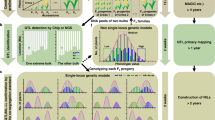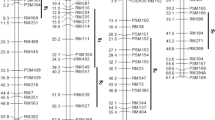Abstract
Quantitative trait loci (QTLs) for plant height in rice were mapped on to RFLP maps in five populations, whose sizes varied from 135 to 250. A total of 23 QTLs were located in all 12 rice chromosomes, and eight of these QTLs were shared by at least two populations. The positions of the 23 mapped QTLs were compared to the positions of 13 major dwarfing or semi-dwarfing genes previously linked to RFLP markers. Results indicated that all 13 dwarfing or semi-dwarfing genes were in close proximity to the QTLs, providing evidence to support the hypothesis that QTLs and major genes were different alleles of the same loci.
Similar content being viewed by others
Article PDF
References
Abenes, M L P, Tabien, R E, McCouch, S R, Ikeda, R, Ronald, P, Khush, G S, and Huang, N. 1994. Orientation and integration of the classical and molecular genetic maps of chromosome 11 in rice. Euphytica, 76, 81–87.
Ausubel, F M, Brent, R, Kingston, R E, Moore, D D, Seidman, J G. Smith, J A, and Struhl, K. 1993. Current Protocols in Molecular Biology. John Wiley and Sons, New York.
Beavis, W D, Grant, D, Albertsen, M, and Fincher, R. 1991. Quantitative trait loci for plant height in four maize populations and their associations with qualitative genetic loci. Theor Appl Genet, 83, 141–145.
Causse, M A, Fulton, T M, Cho, Y G, Ahn, S N, Chun-Wongse, J, and Wu, K. 1994. Saturated molecular map of the rice genome based on an interspecific backcross population. Genetics, 138, 1251–1274.
Champoux, M C, Wang, G, Sarkarung, S, MacKill, D J, O'Toole, J C, Huang, N, and McCouch, S R. 1995. Locating genes associated with root morphology and drought avoidance in rice via linkage to molecular markers. Theor Appl Genet, 90, 969–981.
Cho, Y G, Eun, M Y, McCouch, S R, and Chae, Y A. 1994. The semidwarf gene, sd-1, of rice (Oryza sativa L.). II. Molecular mapping and marker-assisted selection. Theor Appl Genet, 89, 54–59.
Huang, N, McCouch, S, Mew, T, Parco, A, and Guidedoni, E. 1994. Development of an RFLP map from a doubled haploid population in rice. Rice Genet Newsl, 11, 134–137.
Ideta, O, Yoshimura, A, Matsumoto, T, Tsunematsu, H, and Iwata, N. 1992. Integration of conventional and RFLP linkage maps in rice. I. Chromosomes, 1 2, 3 and 4. Rice Genet Newsl, 9, 128–129.
Irri. 1975. Parentage of IRRI crosses IR1-IR50,000. International Rice Research Institute, Manila, Philippines.
Irri. 1988. Standard evaluation system for rice. International Rice Research Institute, Manila, Philippines.
Ishii, T, Brar, D S, Multani, D S, and Khush, G S. 1994. Molecular tagging of genes for brown planthopper resistance and earliness introgressed from Oryza australiensis into cultivated rice, O. sativa. Genome, 37, 217–221.
Kinoshita, T. 1993. Report of the committee on gene symbolization, nomenclature and linkage groups. Rice Genet Newsl, 10, 7–39.
Kishimoto, N, Foolad, M R, Shimosaka, E, Matsuura, S, and Saito, A. 1993. Alignment of molecular and classical linkage maps of rice, Oryza sativa. PI. Cell Rep, 12, 457–461.
Kurata, N, Nagamura, Y, Tamamoto, K, Harushima, Y, Sue, N, and Wu, J. et al. 1994. A 300 kilobase interval genetic map of rice including 883 expressed sequences. Nature Genetics, 8, 365–372.
Lander, E S, and Botstein, D. 1989. Mapping Mendelian factors underlying quantitative traits using RFLP linkage maps. Genetics, 121, 185–199.
Lander, E S, Green, P, Abrahamson, J, Barlow, A, Daly, M J, Lincoln, S E, and Newburg, L. 1987. MAPMAKER: An interactive computer package for constructing primary genetic linkage maps of experimental and natural populations. Genomics, 1, 174–181.
Liang, C Z, Gu, M H, Pan, X B, Liang, G H, and Zhu, L H. 1994. RFLP tagging of a new semi-dwarfing gene in rice. Theor Appl Genet, 88, 898–900.
Lin, H, Qian, H, Zhuang, J, Lu, J, Min, S, and Xiong, Z. et al. 1996. RFLP mapping of QTLs for yield and related characters in rice (Oryza sativa L.). Theor Appl Genet (in press).
MacKill, D J, Salam, M A, Wang, Z Y, and Tanksley, S D. 1993. A major photoperiod-sensitivity gene tagged with RFLP and isozyme markers in rice. Theor Appl Genet, 85, 536–540.
Robertson, D S. 1985. A possible technique for isolating genie DNA for quantitative traits in plants. J Theor Biol, 117, 1–10.
Ronald, P C, Albano, B, Tabien, R, Abenes, L, Wu, K, McCouch, S R, and Tanksley, S D. 1992. Genetic and physical analysis of the rice bacterial blight disease resistance locus Xa21. Mol Gen Genet, 236, 113–120.
Saito, A, Yano, M, Kishimoto, N, Nakagahra, M, Yoshimura, A, and Saito, A. et al. 1991. Linkage map of restriction fragment length polymorphism loci in rice. Jap J Breeding, 41, 665–670.
Stuber, C W, Lincoln, S E, Wolff, D W, Helentjaris, T, and Lander, E S. 1992. Identification of genetic factors contributing to heterosis in a hybrid from two elite maize inbred lines using molecular markers. Genetics, 132, 823–839.
Wang, G L, MacKill, D J, Bonman, J M, McCouch, S R, Champoux, M, and Nelson, R. 1994. RFLP mapping of genes conferring complete and partial resistance to blast in a durably resistant rice cultivar. Genetics, 136, 1421–1434.
Williams, M N V, Pande, N, Nair, S, Mohan, M, and Bennett, J. 1994. Restriction fragment length polymorphism analysis of polymerase chain reaction products amplified from mapped loci of rice (Oryza sativa L.) genomic DNA. Theor Appl Genet, 82, 489–498.
Wu, P, Zhang, G, Huang, N, and Ladha, J K. 1995a. Non-allelic interaction conditioning spikelet sterility in an F2 population of indica/japonica cross in rice. Theor Appl Genet, 91, 825–829.
Wu, P, Zhang, G, Ladha, J K, McCouch, S R, and Huang, N. 1995b. Molecular-marker-facilitated investigation on the ability to stimulate N2 fixation in the Rhizosphere by irrigated rice plants. Theor Appl Genet, 91, 1177–1183.
Xiao, J, Fulton, T, McCouch, S R, Tanksley, S D, Kishi-Motot, N, and Ohsawa, R. et al. 1992. Progress in integration of the molecular maps of rice. Rice Genet Newsl, 9, 124–128.
Yoshimura, S, Yoshimura, A, Saito, A, Kishimoto, N, Kawase, M, and Yano, M. et al. 1992. RFLP analysis of introgressed chromosomal segments in three near-isogenic lines of rice bacterial blight resistance genes, Xa-1, Xa-3 and Xa-4. Jap. J Genet, 67, 29–37.
Yu, Z. 1991. Molecular mapping of rice (Oryza sativa L.) genes via linkage to restriction fragment length polymorphism (RFLP) markers. Ph. D. Dissertation, Graduate School of Cornell University.
Zhang, G, Angeles, E R, Abenes, M L P, Khush, G S, and Huang, N. 1994. Molecular mapping of a bacterial blight resistance gene on chromosome 8 in rice. Rice Genet Newsl, 11, 142–144.
Author information
Authors and Affiliations
Rights and permissions
About this article
Cite this article
Huang, N., Courtois, B., Khush, G. et al. Association of quantitative trait loci for plant height with major dwarfing genes in rice. Heredity 77, 130–137 (1996). https://doi.org/10.1038/hdy.1996.117
Received:
Issue date:
DOI: https://doi.org/10.1038/hdy.1996.117
Keywords
This article is cited by
-
Characterizing the oligogenic architecture of plant growth phenotypes informs genomic selection approaches in a common wheat population
BMC Genomics (2021)
-
Molecular Dissection of Seedling Salinity Tolerance in Rice (Oryza sativa L.) Using a High-Density GBS-Based SNP Linkage Map
Rice (2016)
-
Bidirectional selective genotyping approach for the identification of quantitative trait loci controlling earliness per se in winter rye (Secale cereale L.)
Journal of Applied Genetics (2016)
-
QTL mapping for nitrogen use efficiency and related physiological and agronomical traits during the vegetative phase in rice under hydroponics
Euphytica (2016)
-
Tagging quantitative trait loci for heading date and plant height in important breeding parents of rice (Oryza sativa)
Euphytica (2014)



